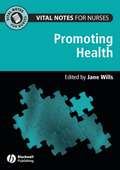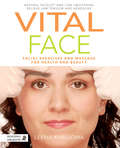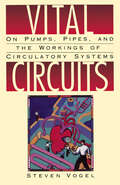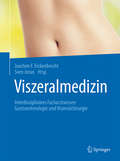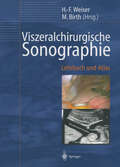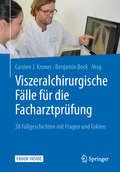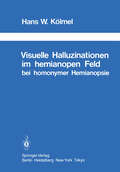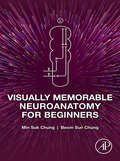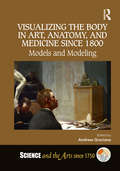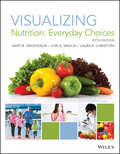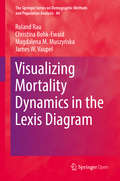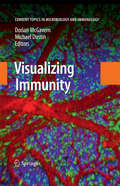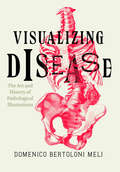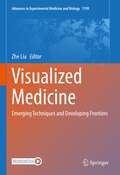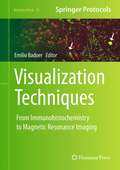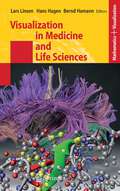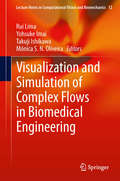- Table View
- List View
Vital Notes for Nurses: Promoting Health (Vital Notes for Nurses #16)
by Jane WillsVital Notes for Nurses: Promoting Health is a concise, accessible introduction to health promotion and public health for pre-registration nursing students and newly qualified nurses. Promoting the health and well-being of patients is a vital part of the nursing role. This introductory text in the Vital Notes for Nurses series explores issues such as public health priorities, health inequalities, health promotion settings, and the role of the nurse in health promotion roles. Written in a clear, accessible style which assumes no prior knowledge Each chapter includes learning objectives, case studies, scenarios, activities and learning outcomes Includes specific application to nursing practice in every chapter Identifies strategies for promoting health with individuals and communities and for protecting the health of the general population
Vital Face: Facial Exercises and Massage for Health and Beauty (PDF)
by Leena KiviluomaThis is a unique, revolutionary and totally natural self-care programme developed to treat muscle based health problems and reduce the signs of ageing. The fully-illustrated handbook guides you through stretching and massage techniques to relax the facial, neck and shoulder muscles, with particular emphasis on the jaw, where tension is often held. The exercises address health issues such as teeth clenching and grinding, pain in the face, jaw, head or neck, and can even improve the effects of Bell's Palsy. They also achieve positive cosmetic results such as reduced facial lines and healthy glowing skin. The strengthening exercises will help to lift the facial features and prevent facial sagging. The impact of each exercise is clearly explained so you can concentrate on techniques to target your individual situation, needs and goals. This supportive guide will help anyone who wants to improve the wellbeing and appearance of the face and neck, and will also be of particular interest to those working in the fields of health and beauty.
Vital Circuits: On Pumps, Pipes, and the Workings of Circulatory Systems
by Steven VogelMost of us think about our circulatory system only when something goes wrong, but the amazing story of how it goes right--"magnificently right," as author Steven Vogel puts it--is equally worthy of our attention. It is physically remarkable, bringing food to (and removing waste from) a hundred trillion cells, coursing through 60,000 miles of arteries and veins (equivalent to over twice around the earth at the equator). And it is also intriguing. For instance, blood leaving the heart flows rapidly through the arteries, then slows down dramatically in the capillaries (to a speed of one mile every fifty days), but in the veins, on its way back to the heart, it speed up again. How? In Vital Circuits, Steven Vogel answers hundreds of such questions, in a fascinating, often witty, and highly original guide to the heart, vessels and blood. Vogel takes us through the realm of biology and into the neighboring fields of physics, fluid mechanics, and chemistry. We relive the discoveries of such scientists as William Harvey and Otto Loewi, and we consider the circulatory systems of such fellow earth-dwellers as octopuses, hummingbirds, sea gulls, alligators, snails, snakes, and giraffes. Vogel is a master at using everyday points of reference to illustrate potentially daunting concepts. Heating systems, kitchen basters, cocktail parties, balloons--all are pressed into service. And we learn not only such practical information as why it's a bad idea to hold your breath when you strain and why you might want to wear support hose on a long airplane flight, but also the answers to such seemingly unrelated issues as why duck breasts (but not chicken breasts) have dark meat and why dust accumulates on the blades of a fan. But the real fascination of Vital Circuits lies neither in its practical advice nor in its trivia. Rather, it is in the detailed picture we construct, piece by piece, of our extraordinary circulatory system. What's more, the author communicates not just information, but the excitement of discovering information. In doing so, he reveals himself to be an eloquent advocate for the cause of science as the most interesting of the humanities. Anyone curious about the workings of the body, whether afflicted with heart trouble or addicted to science watching, will find this book a goldmine of information and oelight.
Viszeralmedizin: Interdisziplinäres Facharztwissen Gastroenterologie und Viszeralchirurgie
by J. F. Erckenbrecht Sven JonasAus den Fachgebieten Gastroenterologie und Viszeralchirurgie entwickelt sich die interdisziplinäre Viszeralmedizin. Das neue Konzept wird an einer zunehmenden Zahl von Kliniken auch organisatorisch umgesetzt und spiegelt sich in dem gemeinsamen Jahreskongress der beiden Fachgesellschaften wider. Mit der „ Interdisziplinären Viszeralmedizin“ greift erstmals ein Buch diese Entwicklung auf: In kompakter, stichwortartiger Form wird das klinische Fachwissen zu den Erkrankungen und Funktionsstörungen der Bauchorgane, den diagnostischen und therapeutischen Möglichkeiten dargestellt. Zu allen Themen mit interdisziplinärem Bezug wurde von internistischen und chirurgischen Autoren ein gemeinsames Kapitel erarbeitet. Kontroverse Fragen der fachlichen Diskussion werden gezielt herausgegriffen und der aktuelle Stand skizziert. Die ideale Grundlage für die interdisziplinäre Arbeit auf der viszeralchirurgischen Station!
Viszeralchirurgische Sonographie: Lehrbuch und Atlas
by H. F. Weiser M. BirthDie Viszeralchirurgie ist eine der wichtigsten chirurgischen Subdisziplinen. Ihre Anwendung erfordert spezielle sonographische Kenntnisse, die über das in der Weiterbildungsordnung geforderte Grundwissen weit hinausgehen.Das Buch bietet Fachärzten und Assistenten topaktuelles Standardwissen für die klinische Praxis und Weiterbildung. Umfassend und praxisorientiert:o Die gesamte Sonographie des Abdomens aus viszeralchirurgischer Sicht ist erfaßt.o Das Standardwissen wird ergänzt durch die laparoskopische, 3D- und Duplexsonographie.o Prä- und postoperative Befunde sind berücksichtigt.Übersichtlich und lerngerecht:o Alle Kapitel sind einheitlich strukturiert und damit besonders benutzerfreundlich.o Die klare Didaktik erleichtert das schnelle Erfassen und gezielte Nachlesen.o Mit neuer Technik für die optimale Wissensvermittlung: sonographische Originalabbildungen werden nach EDV-gestützter Aufbereitung interessierender Areale korrespondierend zueinander dargestellt.Der ideale Praxis-Leitfaden für die qualifizierte sonographische Ausbildung und die sichere Anwendung der Sonographie im viszeralchirurgischen Klinikalltag.
Viszeralchirurgische Operationen und technische Varianten: Ösophagus - Leber - Pankreas - Endokrine Chirurgie - Metabolische Chirurgie
by Michael Korenkov Christoph-Thomas Germer Hauke LangZu wichtigen Operationsverfahren werden bewährte technische Varianten von internationalen Experten Schritt für Schritt in Wort und Bild dargestellt. Ihre Kenntnis ermöglicht bei unerwarteten intraoperativen Situationen oder Komplikationen den Rückgriff auf ein breites Spektrum von Techniken. Sowohl konventionelle als auch minimalinvasive Eingriffe sind berücksichtigt. Das Buch umfasst Operationen aus der Ösophagus-, Leber- und Pankreaschirurgie, der endokrinen und der bariatrischen und metabolischen Chirurgie. Nach dem gleichen Konzept und mit den gleichen Herausgebern ist der Band "Gastrointestinale Operationen und technische Varianten" mit Operationsvarianten an Magen, Gallenorganen, Dünndarm, Kolon und Rektum erschienen. Zu ausgewählten Operationen sind Videos verfügbar, die mit der kostenlosen SN MoreMedia App durch Scannen der Abbildungen im Buch aufgerufen werden können.
Viszeralchirurgische Fälle für die Facharztprüfung: 38 Fallgeschichten mit Fragen und Fakten
by Carsten J. Krones Benjamin Bock38 Kapitel bieten Alltagssituationen aus allen Bereichen des Fachgebietes als lebendige Beschreibungen: die Ärztinnen und Ärzte einer fiktiven viszeralchirurgischen Abteilung, die Patienten untersuchen, Diagnosen stellen und die richtige Therapie mit ihren Kollegen diskutieren, sind individuelle Menschen mit eigenen Ansichten, Plänen und Reaktionsweisen. Aber auch die Sorgen und Fragen der Patienten kommen nicht zu kurz. Die Fallgeschichten bieten den Rahmen für harte Fakten: präzise und kompakte Wissensportionen informieren zu Fragen, wie sie der Oberarzt während der Operation oder der Prüfer bei der Facharztprüfung stellen könnte; im Kontext der Geschichten prägen sie sich ins Gedächtnis ein. Tauchen Sie ein in die Atmosphäre und das konzentrierte Fachwissen einer chirurgischen Abteilung!
Viszeralchirurgie Fragen und Antworten: 1200 Fakten für die Facharztprüfung Viszeralchirurgie und Allgemeinchirurgie
by Michael HeiseFit für den chirurgischen Alltag und die Facharztprüfung? Welche Risikofaktoren bestehen für die Entwicklung eines Pankreaskarzinoms? Welche diagnostischen Maßnahmen erfordert das Staging eines Magenkarzinoms? Zu welchen Komplikationen kann es bei einer Sigmadivertikulitis kommen?1200 Fakten, zusammengefasst in 240 Multiple-Choice-Fragen. Alle Antworten sind kurz und prägnant kommentiert, mit Blick auf das Wesentliche: ideal zum Wiederholen und zur Selbstkontrolle, besonders geeignet für kurze Pausen und Wartezeiten: schnell ein paar Fakten anschauen!
Viszeralchirurgie Fragen und Antworten: 1250 Fakten für die Facharztprüfung Viszeralchirurgie und Allgemeinchirurgie
by Michael Heise Katharina SchulteBereit für die Facharztprüfung und den chirurgischen Alltag?Wie ist das Behandlungsschema beim Rektumkarzinom?Welche chirurgischen Therapieoptionen bestehen beim Gallenblasenkarzinom?Wie werden postoperative Komplikationen erkannt und behandelt? Mehr als 1250 Fakten aus den aktuellsten Leitlinien und Empfehlungen, nach Themenkomplexen geordnet zusammengefasst in über 250 Multiple-Choice-Fragen. Alle Antworten sind kurz, prägnant und nach aktuellsten Leitlinien kommentiert. Neu in der 2. Auflage sind Kapitel zur perioperativen Medizin, chronisch-entzündlichen Darmkrankheiten, onkologischen Chirurgie, palliativen Medizin und zum Komplikationsmanagement. Alle Fragen können zusätzlich mit der Springer Nature Flashcards App aufgerufen werden, welche auch die systematische Wiederholung und die Auswertung des eigenen Wissensstands ermöglicht.
Visuelle Wahrnehmung: Grundlagen, Clinical Reasoning und Intervention im Kindes- und Jugendalter (essentials)
by Andreas LeschnikIn diesem essential werden die Grundlagen des physiologischen/neuronalen Sehens und die Wahrnehmungsverarbeitung erklärt. Außerdem gibt es einen kurzen Überblick über die kindliche Entwicklung des visuellen Systems. Weiterhin zeigt dieses essential auf, welche Formen von visuellen Wahrnehmungsstörungen es gibt. Im weiteren Verlauf wird das hypothetisch-deduktive Clinical Reasoning zum Erstellen einer therapeutischen Diagnose bei Kindern und Jugendlichen mit visuellen Wahrnehmungsstörungen eingesetzt. Abschließend bietet dieses essential Interventionsmöglichkeiten für Kinder und Jugendliche mit visuellen Wahrnehmungsstörungen.
Visuelle Halluzinationen im hemianopen Feld bei homonymer Hemianopsie (Schriftenreihe Neurologie Neurology Series #26)
by H. W. KölmelVisually Memorable Neuroanatomy for Beginners
by Min Suk Chung Beom Sun ChungVisually Memorable Neuroanatomy for Beginners takes a close look at the anatomy of the human brain and teaches readers to identify and examine its structures in a relatable way. Unlike large textbooks that deliver a superficial overview of the subject, this book explores the anatomy and physiology of the brain using mnemonic techniques and informative comic figures that present brain regions at an introductory level, allowing readers to easily identify different parts of the brain. This volume is appropriate for undergraduate and graduate students, postdoctoral fellows, and researchers in the medicine, health sciences, and biological sciences. Beginning with the morphology of the brain and spinal cord, this book then explores the somatic nerve and autonomic nerve, the cranial nerve and spinal nerve, the function of the brain, and concludes with the development of the nervous system.Features simplified illustrations for understanding the complicated neuroanatomy structuresIntroduces memorizing tips (mnemonics) to help students learnDescribes how best to identify structures in cadaver specimensIncludes comic-style figures to make neuroanatomy approachable for newcomers
Visualizing the Body in Art, Anatomy, and Medicine since 1800: Models and Modeling (Science and the Arts since 1750)
by Andrew GracianoThis book expands the art historical perspective on art’s connection to anatomy and medicine, bringing together in one text several case studies from various methodological perspectives. The contributors focus on the common visual and bodily nature of (figural) art, anatomy, and medicine around the central concept of modeling (posing, exemplifying and fabricating). Topics covered include the role of anatomical study in artistic training, the importance of art and visual literacy in anatomical/medical training and in the dissemination (via models) of medical knowledge/information, and artistic representations of the medical body in the contexts of public health and propaganda.
Visualizing the Body in Art, Anatomy, and Medicine since 1800: Models and Modeling (Science and the Arts since 1750)
by Andrew GracianoThis book expands the art historical perspective on art’s connection to anatomy and medicine, bringing together in one text several case studies from various methodological perspectives. The contributors focus on the common visual and bodily nature of (figural) art, anatomy, and medicine around the central concept of modeling (posing, exemplifying and fabricating). Topics covered include the role of anatomical study in artistic training, the importance of art and visual literacy in anatomical/medical training and in the dissemination (via models) of medical knowledge/information, and artistic representations of the medical body in the contexts of public health and propaganda.
Visualizing Mortality Dynamics in the Lexis Diagram (The Springer Series on Demographic Methods and Population Analysis #44)
by Roland Rau Christina Bohk-Ewald Magdalena M. Muszyńska James W. VaupelThis book visualizes mortality dynamics in the Lexis diagram. While the standard approach of plotting death rates is also covered, the focus in this book is on the depiction of rates of mortality improvement over age and time. This rather novel approach offers a more intuitive understanding of the underlying dynamics, enabling readers to better understand whether period- or cohort-effects were instrumental for the development of mortality in a particular country. Besides maps for single countries, the book includes maps on the dynamics of selected causes of death in the United States, such as cardiovascular diseases or lung cancer. The book also features maps for age-specific contributions to the change in life expectancy, for cancer survival and for seasonality in mortality for selected causes of death in the United States. The book is accompanied by instructions on how to use the freely available R Software to produce these types of surface maps. Readers are encouraged to use the presented tools to visualize other demographic data or any event that can be measured by age and calendar time, allowing them to adapt the methods to their respective research interests. The intended audience is anyone who is interested in visualizing data by age and calendar time; no specialist knowledge is required.This book is open access under a CC BY license.
Visualizing Immunity (Current Topics in Microbiology and Immunology #334)
by Dorian McGavern Michael DustinResearchers have used a variety of techniques over the past century to gain fun- mental insights in the field of immunology and, as technology has advanced, so too has the ability of researchers to delve deeper into the biological mechanics of immunity. The immune system is exceedingly complex and must patrol the entire body to protect us from foreign invaders. This requires the immune system to be highly mobile and adaptable - able to respond to diverse microbial challenges while maintaining the ability to distinguish self from a foreign invader. This latter feature is of great importance because the immune system is equipped with toxic mediators, and a failure in self/non-self discrimination can result in serious diseases. Fortunately, in most cases, the immune system operates within the framework of its elegant design and protects us from diverse microbial challenges without initiating disease. Because the immune system is not confined to a single tissue, a comprehensive understanding of immunity requires that research be conducted at the molecular, cellular, and systems level. Immune cells often find customized solutions to h- dling microbial insults that depend on the tissue(s) in which the pathogen is found.
Visualizing Disease: The Art and History of Pathological Illustrations
by Domenico Bertoloni MeliVisual anatomy books have been a staple of medical practice and study since the mid-sixteenth century. But the visual representation of diseased states followed a very different pattern from anatomy, one we are only now beginning to investigate and understand. With Visualizing Disease, Domenico Bertoloni Meli explores key questions in this domain, opening a new field of inquiry based on the analysis of a rich body of arresting and intellectually challenging images reproduced here both in black and white and in color. Starting in the Renaissance, Bertoloni Meli delves into the wide range of figures involved in the early study and representation of disease, including not just men of medicine, like anatomists, physicians, surgeons, and pathologists, but also draftsmen and engravers. Pathological preparations proved difficult to preserve and represent, and as Bertoloni Meli takes us through a number of different cases from the Renaissance to the mid-nineteenth century, we gain a new understanding of how knowledge of disease, interactions among medical men and artists, and changes in the technologies of preservation and representation of specimens interacted to slowly bring illustration into the medical world.
Visualizing Disease: The Art and History of Pathological Illustrations
by Domenico Bertoloni MeliVisual anatomy books have been a staple of medical practice and study since the mid-sixteenth century. But the visual representation of diseased states followed a very different pattern from anatomy, one we are only now beginning to investigate and understand. With Visualizing Disease, Domenico Bertoloni Meli explores key questions in this domain, opening a new field of inquiry based on the analysis of a rich body of arresting and intellectually challenging images reproduced here both in black and white and in color. Starting in the Renaissance, Bertoloni Meli delves into the wide range of figures involved in the early study and representation of disease, including not just men of medicine, like anatomists, physicians, surgeons, and pathologists, but also draftsmen and engravers. Pathological preparations proved difficult to preserve and represent, and as Bertoloni Meli takes us through a number of different cases from the Renaissance to the mid-nineteenth century, we gain a new understanding of how knowledge of disease, interactions among medical men and artists, and changes in the technologies of preservation and representation of specimens interacted to slowly bring illustration into the medical world.
Visualizing Disease: The Art and History of Pathological Illustrations
by Domenico Bertoloni MeliVisual anatomy books have been a staple of medical practice and study since the mid-sixteenth century. But the visual representation of diseased states followed a very different pattern from anatomy, one we are only now beginning to investigate and understand. With Visualizing Disease, Domenico Bertoloni Meli explores key questions in this domain, opening a new field of inquiry based on the analysis of a rich body of arresting and intellectually challenging images reproduced here both in black and white and in color. Starting in the Renaissance, Bertoloni Meli delves into the wide range of figures involved in the early study and representation of disease, including not just men of medicine, like anatomists, physicians, surgeons, and pathologists, but also draftsmen and engravers. Pathological preparations proved difficult to preserve and represent, and as Bertoloni Meli takes us through a number of different cases from the Renaissance to the mid-nineteenth century, we gain a new understanding of how knowledge of disease, interactions among medical men and artists, and changes in the technologies of preservation and representation of specimens interacted to slowly bring illustration into the medical world.
Visualizing Disease: The Art and History of Pathological Illustrations
by Domenico Bertoloni MeliVisual anatomy books have been a staple of medical practice and study since the mid-sixteenth century. But the visual representation of diseased states followed a very different pattern from anatomy, one we are only now beginning to investigate and understand. With Visualizing Disease, Domenico Bertoloni Meli explores key questions in this domain, opening a new field of inquiry based on the analysis of a rich body of arresting and intellectually challenging images reproduced here both in black and white and in color. Starting in the Renaissance, Bertoloni Meli delves into the wide range of figures involved in the early study and representation of disease, including not just men of medicine, like anatomists, physicians, surgeons, and pathologists, but also draftsmen and engravers. Pathological preparations proved difficult to preserve and represent, and as Bertoloni Meli takes us through a number of different cases from the Renaissance to the mid-nineteenth century, we gain a new understanding of how knowledge of disease, interactions among medical men and artists, and changes in the technologies of preservation and representation of specimens interacted to slowly bring illustration into the medical world.
Visualized Medicine: Emerging Techniques and Developing Frontiers (Advances in Experimental Medicine and Biology #1199)
by Zhe LiuThis book summarizes the recent advancements for visualized medicine in terms of fundamental principles, rapidly emerging techniques and developing frontiers. Especially with the combination of artificial intelligence (AI), medical imaging agents and medical robots, smart medical technologies have been innovated and applied to the clinical uses to serve the fatal human diseases diagnosis, treatment, prognosis and data analysis. This philosophy comprehensively revolutionizes the treatment strategy of human healthcare, and will enable precision medicine and precision surgery further intuitively detectable, smartly analyzable and accurately operational. This book will discuss and conclude: 1) state-of-the-art definition of visualized medicine; 2) advanced techniques and clinical applications of visualized medicine in the past decade; 3) novel frontiers and brand-new technologies, e.g. artificial intelligence (AI), surgical robots, etc. 4) revolutionary impacts on disease diagnosis, treatments and prognosis; 5) future challenges and perspectives.
Visualization Techniques: From Immunohistochemistry to Magnetic Resonance Imaging (Neuromethods #70)
by Emilio BadoerVisualization of chemicals in tissues has seen incredible advances in the past several years. Visualization Techniques: From Immunohistochemistry to Magnetic Resonance Imaging provides practical advice from experts in the field as well as an excellent overview of some of the most important recent advances in visualization. This timely volume explores topics from immunohistochemistry for multiple neurochemicals, detecting expression levels of neurochemicals, following cellular processes and ionic movement, identifying polysynaptic pathways subserving physiological responses to identifying functional changes in vivo. Written for the popular Neuromethods series, this work includes the kind of detailed description and implementation advice that is crucial for getting optimal results in the lab. Meticulous and concise, Visualization Techniques: From Immunohistochemistry to Magnetic Resonance Imaging will prove invaluable for scientists seeking to gain a greater understanding of the practical skills, strengths, and pitfalls that these wonderful and exciting visualization techniques provide.
Visualization in Medicine and Life Sciences (Mathematics and Visualization)
by Lars Linsen Hans Hagen Bernd HamannVisualization technology is becoming increasingly important for medical and biomedical data processing and analysis. The interaction between visualization and medicine is one of the fastest expanding fields, both scientifically and commercially. This book discusses some of the latest visualization techniques and systems for effective analysis of such diverse, large, complex, and multi-source data.
Visualization and Simulation of Complex Flows in Biomedical Engineering (Lecture Notes in Computational Vision and Biomechanics #12)
by Rui Lima Yohsuke Imai Takuji Ishikawa Mónica S. N. OliveiraThis book focuses on the most recent advances in the application of visualization and simulation methods to understand the flow behavior of complex fluids used in biomedical engineering and other related fields. It shows the physiological flow behavior in large arteries, microcirculation, respiratory systems and in biomedical microdevices.
